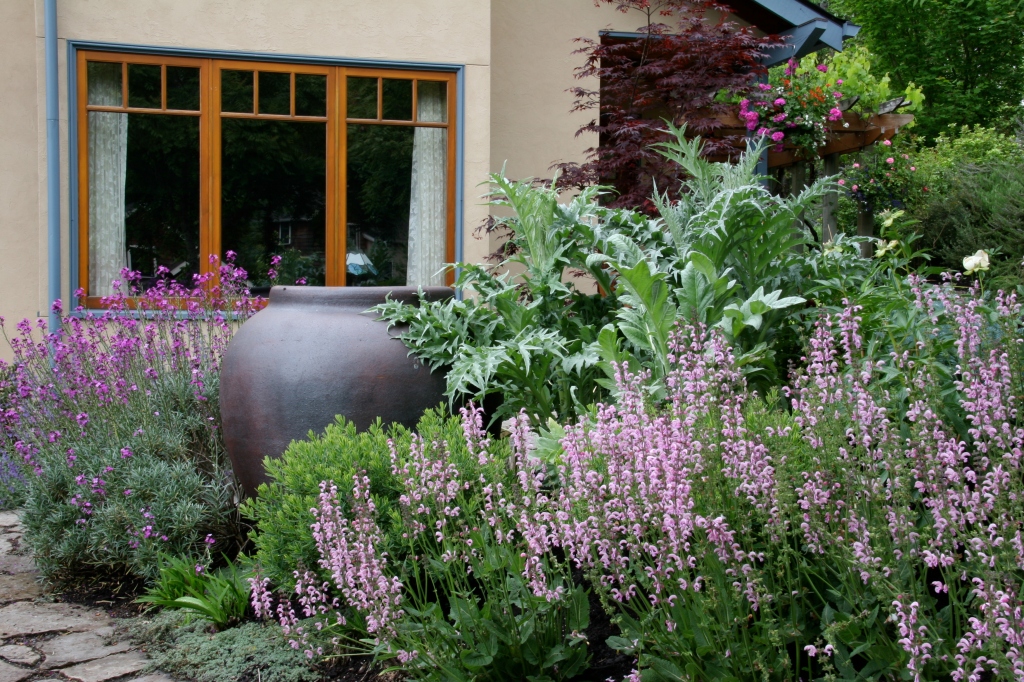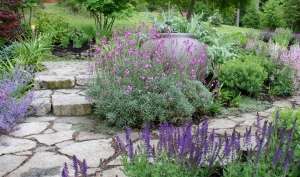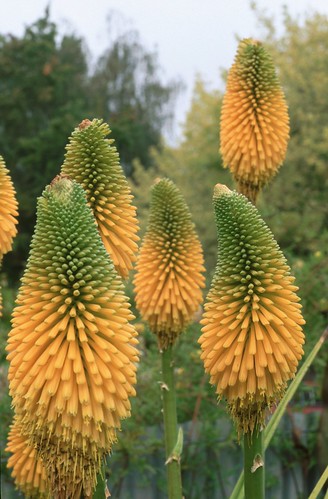What a wonderful June! We've had perfect working weather, fun projects and a terrific garden tour. Thanks again to everyone who came out to support the Symphony Guild at the Music in the Garden event. We hope you had as much fun as we did! In this newsletter, we'll share the transformation of one of the trickiest spaces we've ever seen, offer a few ideas from the resulting garden, and give a summer reading list of five of our favorite garden books. Be sure to scroll through the main journal when you're done. In the last month, we've posted some great pictures, a guide to building simple and great looking tomato cages, a little about how we use metal in our designs and more.
i The Dobson Garden
Ted and Nancy Dobson are determined perfectionists. Everyone in their College Hill neighborhood watched with delight as they scraped, painted and pounded a neglected former rental house into an attractive home. Once the house met their exacting standards, they turned their attention to the yard, expecting to whip it into shape with substantially less effort and time than their house had taken. And then they called us....
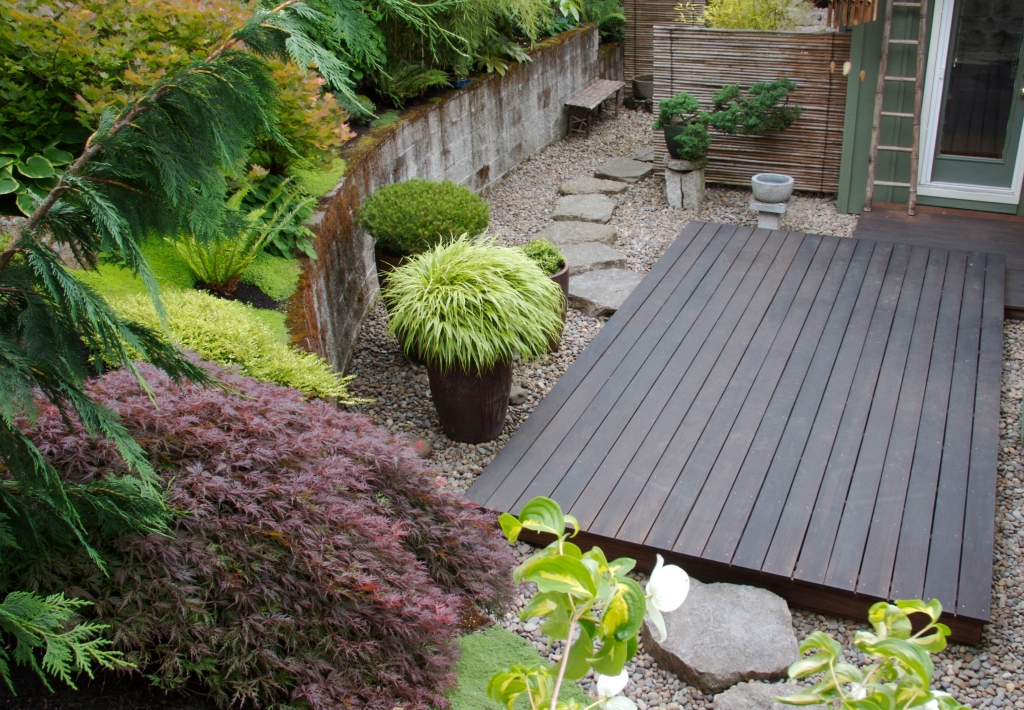
All They Wanted Was a Container Garden
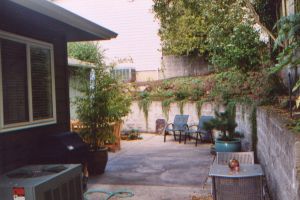
In our initial consultation, Ted and Nancy requested an irrigated container garden in their small back yard. The problem was hiding the irrigation. Previous owners had finished the basement of the house and poured concrete over the entire flat space behind the house. A steep hillside required a tall, cinder block retaining wall. Add in narrow dimensions and a stellar view of the heat pump, and, as you can see below, the space was irrigation-proof and less than attractive.
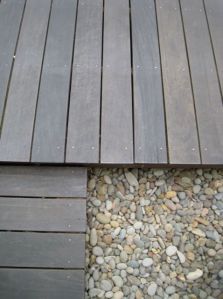
We used four main hardscape elements to create the Dobsons' garden: gravel, ipe (a sustainably forested hardwood) decking, stepping stones and bamboo screens. In a tiny space, everything needs a purpose, and each of these elements blends form and function. A large, local river gravel covers the concrete and irrigation while still allowing water to freely enter the drain system, but visitors only notice its cohesive, subtle texture. The ipe decks give the Dobsons a place to enjoy their garden, and its rich color and strong lines contrast with the lighter, more natural feeling of the stone elements. We borrowed the excellent Japanese concept of using large stepping stones as both a stable walking surface and a way of focusing attention on the journey, rather than the destination, thus keeping energy in the tiny garden. Finally, simple bamboo screens frame an enticing view between separate two garden rooms - the seating area and the pathway or journey garden - and, oh yeah, hide the heat pump from the seating area.
Our design surprised the Dobsons, who had expected a quick meeting about irrigation, but it captured their imaginations. We installed the hardscape of their garden in spring of 2006. At the time, they were casual gardeners, planting a few annuals here and there and keeping a very tidy lawn. However, something in their new space set their prodigious energies and curious minds to work, and they elected to plant the new garden themselves. In the intervening years, Ted and Nancy have created a thoughtful, Japanese-inspired planting, which meshes perfectly with their cool, quiet space.
The gardening didn't stop there, however. The front garden, which expands by the season, is a colorful contrast to the understated space in the back. Today, the Dobsons are regulars on garden tours and make long day trips to check out new nurseries. Every season finds them mulling over a new project and perfecting the existing plantings.
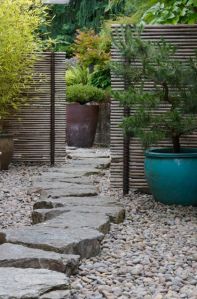
Three Ideas to Borrow
The Dobsons' tricky space is a terrific illustration of some of our core design concepts. Below are three ideas that can help turn a difficult space into an inviting garden.
Think big, even in a small space. Ample hardscape makes a tiny garden more welcoming. Approximately 2' wide stepping stones are an eye-catching invitation to stroll and the 8' x 14' ipe deck is a perfect spot for a glass of wine with friends.
Multitasking hardscape. Combining simple form with multiple functions keeps the garden cohesive and uncluttered. The Dobsons' bamboo screens frame the view of their path, separate the garden rooms, provide a striking backdrop for planted arrangements, and screen the heat pump.
Limitations as framework. More often than not, careful and creative thought can turn an apparent disadvantage into a guideline for great design. The concrete floor of the Dobsons' original "yard" is still under the layers of rich materials. What seemed at first like an unsightly, insurmountable obstacle became the inspiration for a terrific garden.
Summer Garden Reading
Here are five of our favorite garden design books for some summer inspiration. If you can't find them locally (I've seen several of these available used), we've linked to online sources.
The Modern Japanese Garden - This book by Michiko Rico Nose is as much a study in simplicity, honesty of materials and effective use of space as it is a review of contemporary Japanese gardens.
Breaking Ground - The first garden book we loved, and one to which we regularly return for inspiration. A thoughtful introduction to ten contemporary garden designers by Page Dickey.
Gardens in the Spirit of Place - Page Dickey explores gardens that look to the surrounding landscape and culture for their inspiration.
The Essential Garden Book - As close to a "how to" as you can get in garden design, by Terrance Conran.
In the Company of Stone - Daniel Stone is a master in the art and craft of stonework, and this beautiful book by Dan Snow should be on every rock geek's shelves.
Thanks for reading!
We're already brainstorming for the next newsletter. In the meantime, bookmark the journal and check back every few days. In the next month we'll share some process photos of the gorgeous, dry stack stone wall we're building, and, hopefully, some new portfolio shots. If you want to be the first to know about the newsletters and Mosaic news, join our mailing list! We write once or twice a month at most, and we'll never share your contact information.
Happy summer!
Rebecca & Buell
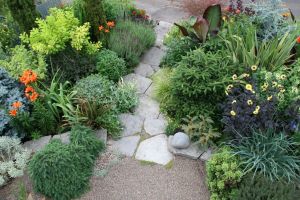 With the
With the 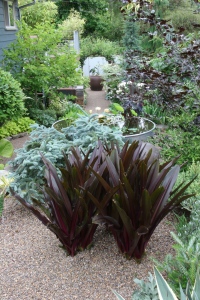 Please join us for the Eugene Symphony Guild's Music in the Garden tour on Sunday, June 14, 10am - 4pm. The tour will feature seven terrific Eugene Gardens,
Please join us for the Eugene Symphony Guild's Music in the Garden tour on Sunday, June 14, 10am - 4pm. The tour will feature seven terrific Eugene Gardens, 
